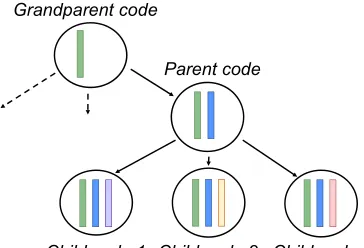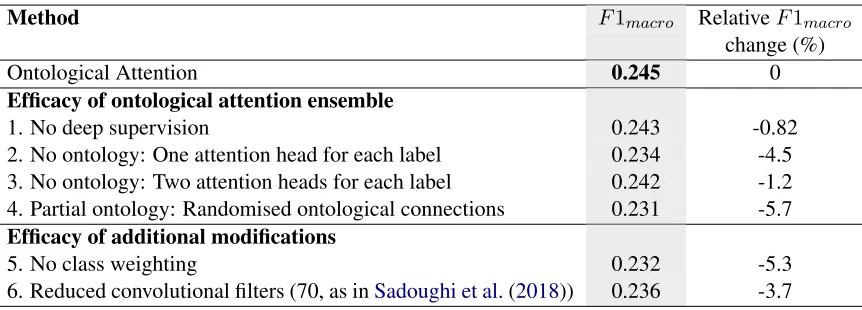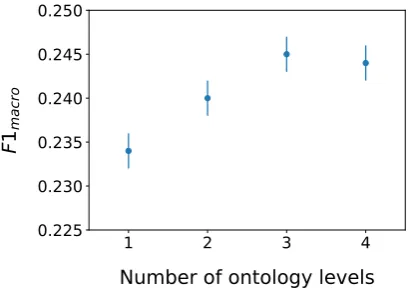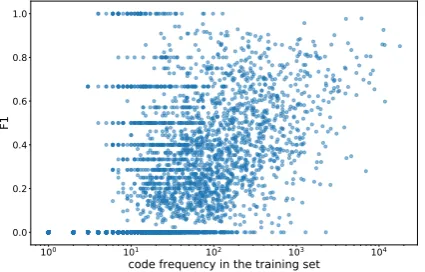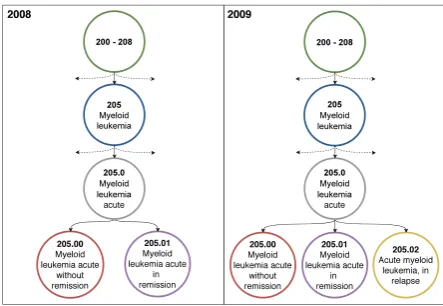Proceedings of the 10th International Workshop on Health Text Mining and Information Analysis (LOUHI 2019), pages 168–177
168
Ontological attention ensembles for capturing semantic concepts in ICD
code prediction from clinical text
Mat ´u˘s Falis1∗, Maciej Pajak1∗, Aneta Lisowska1∗, Patrick Schrempf1,3, Lucas Deckers1, Shadia Mikhael1, Sotirios A. Tsaftaris1,2and Alison Q. O’Neil1,2
1Canon Medical Research Europe, Edinburgh, UK 2 University of Edinburgh, Edinburgh, UK 3University of St Andrews, St Andrews, UK
{matus.falis, maciej.pajak, aneta.lisowska}@eu.medical.canon,
{patrick.schrempf, lucas.deckers, shadia.mikhael}@eu.medical.canon,
s.tsaftaris@ed.ac.uk, alison.oneil@eu.medical.canon
Abstract
We present a semantically interpretable system for automated ICD coding of clinical text doc-uments. Our contribution is an ontological at-tention mechanism which matches the struc-ture of the ICD ontology, in which shared at-tention vectors are learned at each level of the hierarchy, and combined into label-dependent ensembles. Analysis of the attention heads shows that shared concepts are learned by the lowest common denominator node. This al-lows child nodes to focus on the differentiat-ing concepts, leaddifferentiat-ing to efficient learndifferentiat-ing and memory usage. Visualisation of the multi-level attention on the original text allows ex-planation of the code predictions according to the semantics of the ICD ontology. On the MIMIC-III dataset we achieve a 2.7% abso-lute (11% relative) improvement from 0.218 to 0.245 macro-F1 score compared to the previ-ous state of the art across 3,912 codes. Finally, we analyse the labelling inconsistencies aris-ing from different codaris-ing practices which limit performance on this task.
1 Introduction
Classification of clinical free-text documents poses some difficult technical challenges. One task of active research is the assignment of diag-nostic and procedural International Classification of Diseases (ICD) codes. These codes are assigned retrospectively to hospital admissions based on the medical record, for population disease statistics and for reimbursements for hospitals in countries such as the United States. As manual coding is both time-consuming and error-prone, automation of the coding process is desirable. Coding errors may result in unpaid claims and loss of revenue (Adams et al.,2002).
Automated matching of unstructured text to medical codes is difficult because of the large
∗
equal contribution
number of possible codes, the high class imbal-ance in the data, and the ambiguous language and frequent lack of exposition in clinical text. How-ever, the release of large datasets such as MIMIC-III (Johnson et al., 2016) has paved the way for progress, enabling rule-based systems (Farkas and Szarvas, 2008) and classical machine learning methods such as support vector machines ( Suomi-nen et al., 2008), to be superseded by neural network-based approaches (Baumel et al., 2017; Karimi et al.,2017;Shi et al.,2018;Duarte et al., 2018;Rios and Kavuluru, 2018). The most suc-cessful reported model on the ICD coding task is a shallow convolutional neural network (CNN) model with label-dependent attention introduced by Mullenbach et al. (2018) and extended by Sadoughi et al. (2018) with multi-view convolu-tion and a modified label regularisaconvolu-tion module.
One of the common features of the aforemen-tioned neural network models is the use of atten-tion mechanisms (Vaswani et al.,2017). This mir-rors advances in general representation learning. In the text domain, use of multi-headed attention has been core to the development ofTransformer -based language models (Devlin et al.,2018; Rad-ford et al.,2019). In the imaging domain, authors have had success with combining attention vectors learned at the global and local levels with
Dou-ble Attentionnetworks (Chen et al.,2018). In the
domain of structured (coded) medical data,Choi et al. (2017) leveraged the ontological structure of the ICD and SNOMED CT coding systems in theirGRAM model, to combine the attention vec-tors of a code and its ancesvec-tors in order to predict the codes for the next patient visit based on the codes assigned in the previous visit.
Our contributions are:
Dataset # Documents # Unique patients # ICD-9 Codes # Unique ICD-9 codes
Training 47,719 36,997 758,212 8,692
Development 1,631 1,374 28,896 3,012
Test 3,372 2,755 61,578 4,085
Total 52,722 41,126 848,686 8,929
Table 1: Distribution of documents and codes in the MIMIC-III dataset.
2. An analysis of the multi-level attention weights with respect to the text input, which allows us to interpret the code predictions ac-cording to the semantics of the ICD ontology. 3. An analysis of the limitations of the MIMIC-III dataset, in particular the labelling incon-sistencies arising from variable coding prac-tices between coders and between timepoints.
2 Dataset
We used the MIMIC-III dataset (Johnson et al., 2016) (“Medical Information Mart for Intensive Care”) which comes from the intensive care unit of the Beth Israel Deaconess Medical Center in Boston. We concatenated the hospital discharge summaries associated with each admission to form a single document and combined the correspond-ing ICD-9 codes. The data was split into traincorrespond-ing, development, and test patient sets according to the split ofMullenbach et al.(2018) (see Table1).
3 Methods
We formulate the problem as a multi-label binary classification task, for which each hospital dis-charge summary is labelled with the presence or absence of the complete set of ICD-9 codes for the associated admission. Our model is a CNN simi-lar to those of (Mullenbach et al.,2018;Sadoughi et al., 2018). Inspired by the graph-based atten-tion model of (Choi et al., 2017), we propose a hierarchical attention mechanism (mirroring the ICD ontology) which yields a multi-level, label-dependent ensemble of attention vectors for pre-dicting each code. Our architecture is shown in Figure1and described below.
3.1 Embedding
Documents were pre-processed by lower-casing the text and removing punctuation, followed by tokenisation during which purely numeric tokens were discarded. We used a maximum input length of 4500 tokens and truncated any docu-ments longer than this (260 training, 16
devel-opment, and 22 test). Tokens were then embed-ded with a 100-dimensional word2vec model. For each document, token embeddings were concate-nated to give a100×Ndocument embedding ma-trixD, whereN is the document length.
We pre-trained the word2vec model on the training set using continuous bag-of-words (CBOW) (Mikolov et al., 2013). The vocabulary comprises tokens which occur in at least 3 doc-uments (51,847 tokens). The embedding model was fine-tuned (not frozen) during subsequent supervised training of the complete model.
3.2 Convolutional module
The first part of the network proper consists of a multi-view convolutional module, as intro-duced by Sadoughi et al. (2018). Multiple one-dimensional convolutional kernels of varying size with stride = 1 and weightsW are applied in par-allel to the document embedding matrixDalong theN dimension. The outputs of these kernels are padded at each end to match the input lengthN. This yields outputs of sizeC×M ×N whereC
is the number of kernel sizes (“views”),M is the number of filter maps per view, andNis the length of the document. The outputs are max-pooled in theC dimension i.e., across each set of views, to yield a matrixEof dimensionsM ×N:
E =tanh( max
C=[0,3]WC
∗D) (1)
Optimal values were C = 4 filters of lengths
{6, 8, 10, 12}withM = 256filter maps each.
3.3 Prediction via label-dependent attention
Label-specific attention vectors are employed to collapse the variable-lengthEdocument represen-tations down to fixed-length represenrepresen-tations. For each labell, given the matrixE as input, a token-wise linear layerulis trained to generate a vector
of length N. This is normalised with a softmax operation, resulting in an attention vectoral:
Grandparent Label-wise
Attention Parent Label-wise
Attention Code Label-wise
Attention
• • •
Grandparent Prediction Concatenation
Parent Prediction Concatenation
Child Prediction
Max Pooling
Input
Embedding
Multi-view
Convolution Parent
to Child Mapping
[image:3.595.73.525.67.303.2]Grandparent to Parent Mapping
Figure 1: Network architecture. The output of the convolutional module is fed into the ensemble of ancestral attention heads for multi-task learning. Circles with dots represent matrix product operations. Ancestors are mapped to descendants by multiplication with a mapping connectivity matrix based on the ontology structure.
The attention vector is then multiplied with the matrixEwhich yields a vector vlof lengthM, a
document representation specific to a label:
vl=alE (3)
If multiple linear layersul,0, ul,1, . . .are trained
for each label at this stage, multiple attention vec-tors (or “heads”) will be generated. Thus, multiple document representationsvlcould be made
avail-able, each of lengthM, and concatenated together to form a longer label-specific representation for the document. We experimented with multiple at-tention vectors and found two vectors per label to be optimal. To make a prediction of the probabil-ity of each label,P(l), there is a final dense binary classification layer with sigmoid activation. This is shown for two attention vectors:
P(l) =σ(Wl[vl,0;vl,1] +βl) (4)
3.4 Prediction via label-dependent ontological attention ensembles
The ICD-9 codes are defined as an ontology, from more general categories down to more specific descriptions of diagnosis and procedure. Rather than simply training two attention heads per code as shown in Section 3.3, we propose to exploit the ontological structure to train shared attention heads between codes on the same branch of the
tree, thus pooling information across labels which share ancestry. In this work, we use two levels of ancestry, where the first level corresponds to the pre-floating-point portion of the code. For in-stance, for the code425.11 Hypertrophic
obstruc-tive cardiomyopathy, the first-degree ancestor is
425 Cardiomyopathy and the second-degree
an-cestor is420-429 Other forms of heart disease(the chapter in which the parent occurs). This is illus-trated in Figure2.
Child code 1 Child code 2 Child code 3 Parent code
Grandparent code
Figure 2: Illustration of inheritance of the linear layers ul. This yields label-specific ontological attention
en-sembles of the attention headsaland subsequently the
document representationsvl.
[image:3.595.329.511.536.660.2]identi-fied 1167 first-degree ancestors and 179 second-degree ancestors. Compared to two attention vec-tors per code, this reduces the parameter space and memory requirements from 17,858 attention heads (8929 x 2) to 10,275 attention heads (8929 + 1167 + 179) as well as increasing the number of training samples for each attention head.
The label prediction for each code is now de-rived from the concatenated child (c), parent (p) and grandparent (gp) document representations:
P(lchild) =σ(Wlc[vl,c;vl,p;vl,gp] +βlc) (5)
In order to facilitate learning of multiple atten-tion heads, we employ deep supervision using the ancestral labels, adding auxiliary outputs for pre-dicting the parent and grandparent nodes:
P(lparent) =σ(Wlp[vl,p;vl,gp] +βlp) (6)
P(lgrandparent) =σ(Wlgp[vl,gp] +βlgp) (7)
3.5 Training process
We trained our model with weighted binary cross entropy loss using the Adam optimiser (Kingma and Ba,2014) with learning rate0.0005.
Stratified shuffling: The network accepts in-put of any length but all instances within a single batch need to be padded to the same length. To minimise the amount of padding, we used length-stratified shuffling between epochs. For this, doc-uments were grouped by length and shuffled only within these groups; groups were themselves then shuffled before batch selection started.
Dampened class weighting: We employed the standard practice of loss weighting to prevent the imbalanced dataset from affecting performance on rare classes. We used a softer alternative to em-pirical class re-weighting, by taking the inverse frequencies of positive (label= 1) and negative (label= 0) examples for each codec, and adding a damping factor α. In the equations below,
nlabelc=1 stands for the number of positive exam-ples for the ICD codec, andnstands for the total number of documents in the dataset.
ω(c,1)=
n nlabelc=1
α
ω(c,0)=
n nlabelc=0
α (8)
Upweighting for codes with 5 examples or fewer, where we do not expect to perform well in any case, was removed altogether as follows:
ω(c,1) =
( n
nlabelc=1
α
, nlabelc=1 >5
1 ,otherwise (9)
Deep supervision: The loss function was weighted in favour of child codes, with progres-sively less weight given to the codes at higher lev-els in the ICD ontology. A weighting of 1 was used for the child code loss, a weightingwhfor the
par-ent code auxiliary loss, andw2hfor the grandparent code auxiliary loss, i.e.,
Loss=Lc+whLp+wh2Lgp (10)
Optimal values wereα= 0.25andwh = 0.1.
3.6 Implementation and hyperparameters
The word2vec embedding was implemented with Gensim (Reh˚uˇrek and Sojkaˇ , 2010) and the ICD coding model was implemented with PyTorch (Paszke et al., 2017). Experiments were run on Nvidia V100 16GB GPUs. Hyperparameter val-ues were selected by maximising the development set macro-F1 score for codes with more than 5 training examples.
4 Experiments
4.1 Results
In our evaluation, we focus on performance across all codes and hence we prioritise macro-averaged metrics, in particular macro-averaged precision, recall, and F1 score. Micro-averaged F1 score and Precision at k (P@K) are also reported in order to directly benchmark performance against previ-ously reported metrics. All reported numbers are the average of 5 runs, starting from different ran-dom network initialisations.
We compare our model to two previous state-of-the-art models: Mullenbach et al. (2018), and Sadoughi et al.(2018) (published only on arXiv). We trained these models with the hyperparameter values quoted in the respective publications, and used the same early stopping criteria as for our model. Both Mullenbachet al.and Sadoughiet al.
Method Rmacro Pmacro F1macro F1micro P@8
Mullenbach et al.(2018) 0.218 0.195 0.206 0.499 0.651
Sadoughi et al.(2018) 0.261 0.186 0.218 0.498 0.662
[image:5.595.97.503.62.118.2]Ontological Attention 0.341 0.192 0.245 0.497 0.681
Table 2: Benchmark results for the models trained withF1macrostopping criterion.
Method Rmicro Pmicro F1macro F1micro P@8
Mullenbach et al.(2018) 0.469 0.593 0.172 0.523 0.685
Sadoughi et al.(2018) 0.516 0.560 0.173 0.537 0.695
[image:5.595.98.501.152.208.2]Ontological Attention 0.514 0.617 0.206 0.560 0.727
Table 3: Benchmark results for the models trained withF1microstopping criterion.
Method F1macro RelativeF1macro
change (%)
Ontological Attention 0.245 0
Efficacy of ontological attention ensemble
1. No deep supervision 0.243 -0.82
2. No ontology: One attention head for each label 0.234 -4.5 3. No ontology: Two attention heads for each label 0.242 -1.2 4. Partial ontology: Randomised ontological connections 0.231 -5.7 Efficacy of additional modifications
5. No class weighting 0.232 -5.3
6. Reduced convolutional filters (70, as inSadoughi et al.(2018)) 0.236 -3.7
Table 4: Ablation study of individual components of the final method. All models are trained with theF1macro
stopping criterion. Experiments 2 and 3 do not use the ontological attention mechanism, and instead have one or two attention heads respectively per code-level label. For experiment 4, child-parent and parent-grandparent connections were randomised, removing shared semantics between codes across the full 3 levels.
is included in the model reported here. However, this regularisation is not used in our own model where we observed no benefit.
Overall results are shown in Table 2. Our method significantly outperforms the benchmarks on macro-F1 andP@8.
Previous models have optimised for F1 micro-average. Different target metrics require different design choices: after removal of the class weight-ing in the loss function and when usweight-ingF1micro
as our stopping criterion, we are also able to sur-pass previous state-of-the-art results on micro-F1. The results are presented in Table3; our method achieves the highestF1micro score, as well as the
highest P@8 score. We note that P@8 score is consistently higher for models stopped using the
F1microcriterion.
In Table4we present an ablation study. It can be seen that the improvement in performance of the ontological attention model is not simply due to increased capacity of the network, since even
with 73% greater capacity (17,858 compared to 10,275 attention vectors), the two-vector multi-headed model has a 1.2% drop in performance. Experiments with deep supervision and randomi-sation of the ontology graph connections show the benefit of each component of the ontological ar-chitecture. We also measure the effect of addi-tional changes made during optimisation of the ar-chitecture and training.
[image:5.595.84.515.239.394.2]21 nodes are split between diagnostic codes.
Figure 3: F1macrofor models using attention
ensem-bles across different levels of the ontological tree. Error bars represent the standard deviation across 5 different random weight initialisations. The model with 1 level has only the code-level attention head, the model with 2 levels also includes the shared parent attention heads; the model with 3 levels adds the shared grandparent attention heads (this is our reported Ontological Atten-tion model), and finally, the model with 4 levels adds shared great-grandparent attention heads.
4.2 Analysis of the attention weights
In Figure 4 we show how the weights of code-level ul vectors (which give rise to the attention
heads) change when the ontological attention en-semble mechanism is introduced. As expected, we observe that in the case of a single attention head, the weights for different codes largely clus-ter together based on their position in the ontology graph. Once the parent and grandparent attention heads are trained, the ontological similarity struc-ture on the code level mostly disappears. This sug-gests that the common features of all codes within a parent group are already extracted by the parent attention. thus, the capacity of the code-level at-tention is spent on the representation of the differ-ences between the descendants of a single parent.
4.3 Interpretability of the attention heads
In Section 4.2, we showed the links between the ontology and the attention heads within the space of theul vector weights. We can widen this
anal-ysis to links between the predictions and the in-put, by examining which words in the input docu-ments are attended by the three levels of attention heads for a given label. A qualitative visual ex-ample is shown in Figure5. We performed quan-titative frequency analysis of high-attention terms
(keywords) in the training set. A term was consid-ered a keyword if its attention weight in a docu-ment surpassed the thresholdtkw:
tkw(N, γkw) =γkw 1
N, (11)
whereN is the length of a document andγkw is
a scalar parameter controlling the strictness of the threshold. Withγkw = 1, a term is considered a
keyword if its attention weight surpasses the uni-formly distributed attention. In our analysis we choseγkw= 17for all documents.
We aggregated these keywords across all pre-dicted labels in the training set, counting how many times a term is considered a keyword for a label. The results of this analysis are in line with our qualitative analysis of attention maps. The most frequent keywords for the labels presented in the example in Figure5include “cancer”, “ca”, “tumor”, at the grandparent level (focusing on the concept of cancer); “metastatic”, “metastases” and “metastasis” at the parent level (focusing on the concept of metastasis); and “brain”, “craniotomy”, “frontal” at the code-level (focusing on terms re-lating to specific anatomy). A sibling code (198.5 Secondary malignant neoplasm of bone and bone
marrow) displays similar behaviour in focusing on
anatomy, with “bone”, “spine”, and “back” being among the most frequent keywords.
Not all codes display such structured behaviour. For instance, the grandparent 401-405
Hyperten-sive disease attended to the term “hypertension”
most frequently. The parent code 401 Essential
hypertension, does not attend to “hypertension”,
but neither does it attend to any useful keywords — this may be due to the code being simple com-pared to its sibling codes, which are more spe-cific (e.g., 402 Hypertensive heart disease). In-terestingly, the children of 401 Essential
hyper-tension attend to the word “hypertension” again,
while also focusing on terms that set them apart from each other — e.g.,401.0 Malignant
essen-tial hypertension focuses on terms implying
ma-lignancy, such as “urgency”, “emergency”, and “hemorrhage”.
5 Limitations due to labelling variability
15 10 5 0 5 10 15 15
10 5 0 5 10 15
038 Septicemia
041 Bacterial infection in conditions classified elsewhere and of unspecified site 250 Diabetes mellitus
276 Disorders of fluid, electrolyte, and acid-base balance 34 Operations on chest wall, pleura,
mediastinum, and diaphragm 36 Operations on vessels of heart 37 Other operations on heart and pericardium 38 Incision, excision, and occlusion of vessels 39 Other operations on vessels
410 Acute myocardial infarction 427 Cardiac dysrhythmias 428 Heart failure
45 Incision, excision, and anastomosis of intestine 707 Chronic ulcer of skin
765 Disorders relating to short gestation and unspecified low birthweight
V10 Personal history of malignant neoplasm
031-040 Other Bacterial Diseases
425-429 Other Forms of Heart Disease
35-39 Operations on the
Cardiovascular System Procedures & Diagnoses
related to the Cardiovascular System*
7.5 5.0 2.5 0.0 2.5 5.0 7.5
10.0 7.5 5.0 2.5 0.0 2.5 5.0 7.5 (a)
(b)
[image:7.595.86.525.58.473.2](c)
Figure 4: Two-dimensional t-SNE (Maaten and Hinton,2008) representation of theulvectors (which give rise to
the attention heads) for a subset of 182 codes with at least 100 occurrences each, in the data belonging to 16 differ-ent pardiffer-ent nodes. (a) Legend for the annotation of data points according to their pardiffer-ent node. (b)ulvectors from
the model with only a single attention head for each code (i.e., no ontology). It can be seen that codes naturally cluster by their parent node. Selected higher-level alignments are indicated by additional contours — for grandpar-ent nodes (3 nodes) and for diagnoses/procedure alignmgrandpar-ent (in the case of cardiovascular disease). (c)ulvectors
in the ontological attention ensemble model for the same set of codes (and the same t-SNE hyperparameters). In most cases the clustering disappears, indicating that the attention weights for the ancestral codes have extracted the similarities from descendants’ clusters.
Method Rmacro Pmacro F1macro F1micro P@8
Mullenbach et al.(2018) 0.226 0.200 0.212 0.500 0.651
Sadoughi et al.(2018) 0.272 0.187 0.222 0.497 0.662
Ontological Attention 0.347 0.199 0.252 0.507 0.686
Table 5: Benchmark results for the models trained withF1macrostopping criterion.
variability in accuracy, that is only partially corre-lated with the number of training examples.
Inspection of examples for some of the poorly performing codes revealed some variability in
coding policy, described further below.
5.1 Misreporting of codes
(a)
(b)
[image:8.595.78.291.335.471.2](c)
Figure 5: Discharge summary snippet with highlights generated from attention heads for (a) the grandparent code (190-199 Malignant neoplasm of other and un-specified sites), (b) the parent code (198 Secondary ma-lignant neoplasm of other specified sites), and (c) the specific code (198.3 Secondary malignant neoplasm of brain and spinal cord). Different words and phrases are attended at each level.
Figure 6: Per-code frequency of training examples v.s. F1macroscore from the ontological attention model
and Hill estimated sensitivity and specificity to be 80% and 100% respectively for ICD codes relating to stroke and its risk factors (Kokotailo and Hill, 2005). In the MIMIC-III dataset, we inspected the assignment of smoking codes (current smoker
305.1, past smokerV15.82, or never smoked i.e.,
no code at all), using regular expression matching to identify examples of possible miscoding, fol-lowed by manual inspection of 60 examples (10 relating to each possible miscoding category) to verify our estimates. We estimated that 10% of pa-tients had been wrongly assigned codes, and 30% of patients who had a mention of smoking in their record had not been coded at all. We also observed that often the “correct” code is not clear-cut. For instance, many patients had smoked in the distant past or only smoke occasionally, or had only
re-cently quit; in these cases, where the narrator reli-ability may be questionable, the decision of how to code is a matter of subjective clinical judgement.
5.2 Revisions to the coding standards
Another limitation of working with the MIMIC-III dataset is that during the deidentification pro-cess, information about absolute dates was dis-carded. This is problematic when we consider that the MIMIC-III dataset contains data that was collected between 2001 and 2012, and the ICD-9 coding standard was reviewed and updated annu-ally between 2006 and 2013 (Centers for Medicare & Medicaid Services) i.e., each year some codes were added, removed or updated in their meaning. To investigate this issue, we took the 2008 stan-dard and mapped codes created post-2008 back to this year. In total, we identified 380 codes that are present in the dataset but were not defined in the 2008 standard. An example can be seen in Fig-ure7. We report our results on the 2008 codeset in Table 5. It can be seen that there is an im-provement to the metrics on this dataset, which we expect would increase further if all codes were mapped back to the earliest date of 2001. With-out time data, it is an unfair task to predict codes which are fundamentally time-dependent. This is an interesting example of conflicting interests be-tween (de)identifiability and task authenticity.
During real-world deployment, codes should be assigned according to current standards. In order to use older data, codes should be mapped for-wards rather than backfor-wards. The backfor-wards op-eration was possible by automated re-mapping of the codes, however the forwards operation is more arduous. Newly introduced codes may require an-notation of fresh labels or one-to-many conversion — both operations requiring manual inspection of the original text. A pragmatic approach would be to mask out codes for older documents where they cannot be automatically assigned.
6 Conclusions
improve-Figure 7: Example code added to the ICD-9 standard.
ments in accuracy, in memory efficiency, and in
interpretability. Our method is not specific to an
ontology, and in fact could be used for a graph of any formation. If we were to exploit further con-nections within the ICD ontology e.g., between re-lated diagnoses and procedures, and between child codes which share modifier digits, we would ex-pect to obtain a further performance boost.
We have illustrated that labels may not be reli-ably present or correct. Thus, even where plenty of training examples are available, the performance may (appear to) be low. In practice, the most suc-cessful approach may be to leverage a combination of automated techniques and manual input. An active learning setup would facilitate adoption of new codes by the model as well as allowing en-dorsement of suggested codes which might other-wise have been missed by manual assignment, and we propose this route for future research.
References
Diane L Adams, Helen Norman, and Valentine J Bur-roughs. 2002. Addressing medical coding and billing part ii: a strategy for achieving compliance. a risk management approach for reducing coding and billing errors. Journal of the National Medical As-sociation, 94(6):430.
Tal Baumel, Jumana Nassour-Kassis, Michael Elhadad, and Noemie Elhadad. 2017. Multi-label classifica-tion of patient notes: Case study on ICD code as-signment.ArXiv.
Centers for Medicare & Medicaid Ser-vices. New, deleted, and revised codes - summary tables. https: //www.cms.gov/Medicare/Coding/ ICD9ProviderDiagnosticCodes/
summarytables.html.
Yunpeng Chen, Yannis Kalantidis, Jianshu Li, Shuicheng Yan, and Jiashi Feng. 2018. Aˆ 2-nets: Double attention networks. InAdvances in Neural Information Processing Systems, pages 352–361.
Edward Choi, Mohammad Taha Bahadori, Le Song, Walter F Stewart, and Jimeng Sun. 2017. Gram: graph-based attention model for healthcare repre-sentation learning. InProceedings of the 23rd ACM SIGKDD International Conference on Knowledge Discovery and Data Mining, pages 787–795. ACM.
Jacob Devlin, Ming-Wei Chang, Kenton Lee, and Kristina Toutanova. 2018. Bert: Pre-training of deep bidirectional transformers for language understand-ing.arXiv preprint arXiv:1810.04805.
Francisco Duarte, Bruno Martins, C`atia Sousa Pinto, and M`ario J. Silva. 2018. Deep neural models for icd-10 coding of death certificates and autopsy re-ports in free-text. Journal of Biomedical Informat-ics, 80:64–77.
Rich´ard Farkas and Gy¨orgy Szarvas. 2008. Auto-matic construction of rule-based icd-9-cm coding systems. In BMC bioinformatics, volume 9, page S10. BioMed Central.
AEW Johnson, TJ Pollard, L Shen, L Lehman, M Feng, M Ghassemi, B Moody, P Szolovits, LA Celi, and RG Mark. 2016. Mimic-iii, a freely accessible criti-cal care database. Scientific Data, 3.
Sarvnaz Karimi, Xiang Dai, Hamed Hassanzadeh, and Anthony Nguyen. 2017. Automatic diagnosis cod-ing of radiology reports: a comparison of deep learn-ing and conventional classification methods. In Proc. of the BioNLP 2017 Workshop, pages 328– 332.
Diederik P Kingma and Jimmy Ba. 2014. Adam: A method for stochastic optimization. arXiv preprint arXiv:1412.6980.
Rae A Kokotailo and Michael D Hill. 2005. Coding of stroke and stroke risk factors using international classification of diseases, revisions 9 and 10. Stroke, 36(8):1776–1781.
Laurens van der Maaten and Geoffrey Hinton. 2008. Visualizing data using t-sne. Journal of machine learning research, 9(Nov):2579–2605.
Tomas Mikolov, Kai Chen, Greg Corrado, and Jef-frey Dean. 2013. Efficient estimation of word representations in vector space. arXiv preprint arXiv:1301.3781.
James Mullenbach, Sarah Wiegreffe, Jon Duke, Jimeng Sun, and Jacob Eisenstein. 2018. Explainable Pre-diction of Medical Codes from Clinical Text. Pro-ceedings ofNAACL-HLT 2018, pages 1101–1111.
[image:9.595.71.293.64.217.2]Lerer. 2017. Automatic differentiation in PyTorch. InNIPS Autodiff Workshop.
Alec Radford, Jeffrey Wu, Rewon Child, David Luan, Dario Amodei, and Ilya Sutskever. 2019. Language models are unsupervised multitask learners. OpenAI Blog, 1(8).
Radim ˇReh˚uˇrek and Petr Sojka. 2010. Software Frame-work for Topic Modelling with Large Corpora. In Proceedings of the LREC 2010 Workshop on New Challenges for NLP Frameworks, pages 45–50, Val-letta, Malta. ELRA. http://is.muni.cz/
publication/884893/en.
Anthony Rios and Ramakanth Kavuluru. 2018. Few-shot and zero-Few-shot multi-label learning for structured label spaces. In Proceedings of the 2018 Confer-ence on Empirical Methods in Natural Language Processing, pages 3132–3142.
Najmeh Sadoughi, Greg P. Finley, James Fone, Vi-gnesh Murali, Maxim Korenevski, Slava Barysh-nikov, Nico Axtmann, Mark Miller, and David Suendermann-Oeft. 2018. Medical code predic-tion with multi-view convolupredic-tion and descrippredic-tion- description-regularized label-dependent attention.arXiv.
Haoran Shi, Pengtao Xie, Zhiting Hu, Ming Zhang, and Eric P. Xing. 2018. Towards automated icd coding using deep learning. ArXiv.
Hanna Suominen, Filip Ginter, Sampo Pyysalo, Antti Airola, Tapio Pahikkala, Sanna Salanter¨a, and Tapio Salakoski. 2008. Machine learning to automate the assignment of diagnosis codes to free-text radiology reports: a method description. InProceedings of the ICML/UAI/COLT Workshop on Machine Learning for Health-Care Applications.
